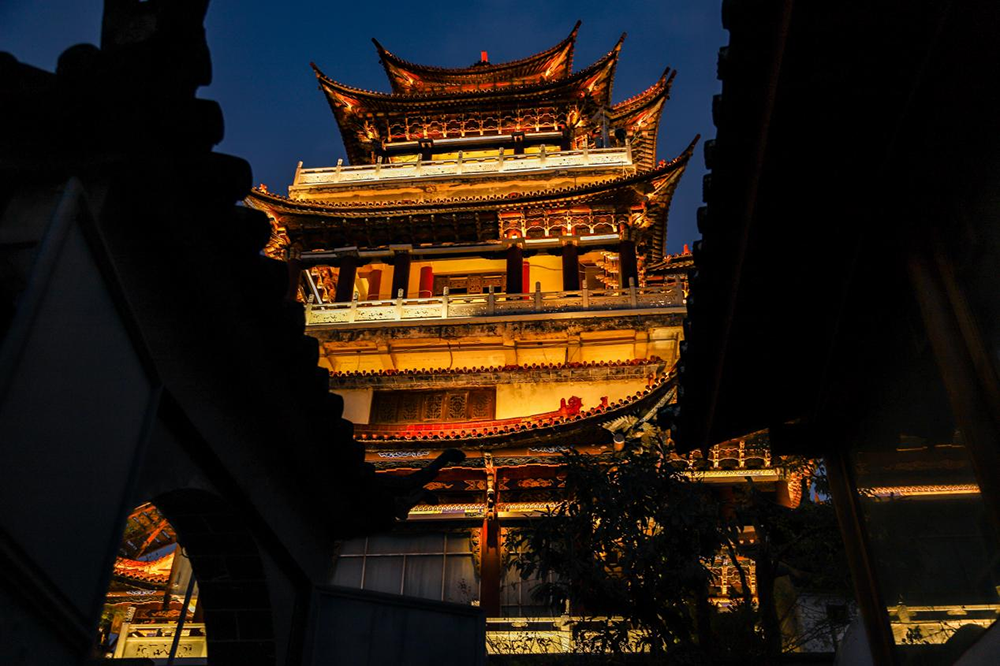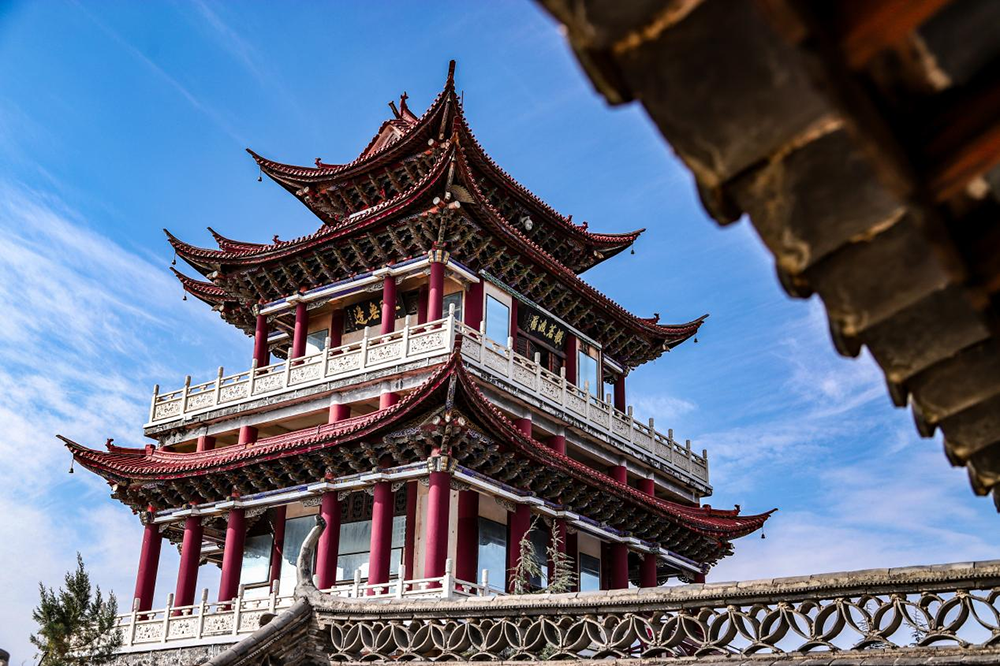The First Pavilion of Erhai Lake - Tianjing Pavilion
Among the four famous pavilions of Erhai Lake, Tianjing Pavilion is the most famous. Perhaps it is customary to arrange them in the order of southeast, northwest, people always list Tianjing Pavilion as the first of the four famous pavilions. However, even without relying on the orientation, Tianjing Pavilion deserves to be the number one pavilion of Erhai Lake based on its scenery and realm. Now, Tianjing Pavilion is the only restored and rebuilt famous pavilion of Erhai Lake, so it is naturally the number one pavilion of Erhai Lake. In fact, the scale and craftsmanship of the currently restored and rebuilt Tianjing Pavilion are so magnificent and exquisite that it is not only the number one pavilion of Erhai Lake, but also the number one pavilion of Dali and Yunnan.
Keyword:
Dali Luoquan
Luoquan Peninsula
Luoquan Pagoda
Tianjing Pavilion
Category:
Spot Description
Local gazetteers and related books clearly state that Erhai Lake has four famous pavilions: Tianjing Pavilion in the east, Haoran Pavilion in the west, Shuiyue Pavilion in Shangguan, and Zhuhai Pavilion in Xiaguan. However, by the Republic of China period, all four pavilions had long disappeared. Only Tianjing Pavilion has been restored and rebuilt, standing again on the southern foot of Xiangbinling, Luoquan Peninsula, on Yu'an Mountain on the east bank of Erhai Lake.
Among the four famous pavilions of Erhai Lake, Tianjing Pavilion is the most famous. Perhaps it is customary to arrange them in the order of southeast, northwest, people always list Tianjing Pavilion as the first of the four famous pavilions. However, even without considering the location, based on the scenery and environment alone, Tianjing Pavilion is undoubtedly the number one pavilion of Erhai Lake. Now, Tianjing Pavilion is the only restored pavilion of Erhai Lake, naturally making it the number one pavilion. In fact, the scale and craftsmanship of the currently restored Tianjing Pavilion are so magnificent that it is not only the number one pavilion of Erhai Lake, but also can be considered the number one pavilion of Dali, and even the number one pavilion of Yunnan.
Tianjing Pavilion was initially built during the Dali Kingdom period, with a history of over a thousand years, and has been destroyed and rebuilt several times. The Qing Dynasty's "Inscription on the Reconstruction of Tianjing Pavilion Temple" states: "The Tianjing Pavilion forest is the best view of Luoquan Mountain. Built since the previous Ming Dynasty, it occupies the dangerous terrain of mountains and seas, and its scenery surpasses the beauty of heaven and earth. Combining Guanyin Pavilion into a temple, it is one of the four pavilions along with Haoran Pavilion in the west of Erhai Lake, Shuiyue Pavilion in Shangguan, and Zhuhai Pavilion in Xiaguan. It is named Tianjing because its scenery surpasses others. The mountain slopes southward, the waves embrace northward, the sea is round and vast, the sky's light shines down and is clear. When the moon reaches the center of the sky, it appears as a mirror within a mirror. When the wind blows on the water's surface, it divides the sky into two, combining the wonders of the upper and lower realms into the name of the pavilion. The construction and naming of the pavilion followed nature." "Built since the previous Ming Dynasty" actually refers to reconstruction, not the initial construction. Li Jing, who served as the Deputy Xuanwei Commissioner (official transmitting government orders) and concurrently managed the Wanhu military and civilians in Yunnan during the Dade years of the Yuan Dynasty, and authored "Yunnan Zhilüe", wrote a poem "Tianjing Pavilion" as evidence. If it was initially built in the previous Ming Dynasty, how could there be a Yuan Dynasty poem? According to "Records of the Beginning and End of Guanyin Pavilion", Guanyin Pavilion was created in the fourth year of Tianfu in the Later Jin Dynasty (939 AD) during the Five Dynasties and Ten Kingdoms period. Referring to the combination of Tianjing Pavilion and Guanyin Pavilion into a temple, it is said that Guanyin Pavilion is the front building of Tianjing Pavilion, and Guanyin Pavilion is the rear palace of Tianjing Pavilion. Tianjing Pavilion should have been built in the early Dali Kingdom period, and at the latest, no later than the Dali Kingdom period.
Li Jing's poem "Tianjing Pavilion" states:
Thousands of peaks outside the railing pierce the sea waves, and the twin pagodas of hibiscus stand tall and majestic.
Silver mountain temples and pavilions are visible in the sky, and black water sails pass by in the mirror.
Fragrant grass, a boat on the vast sea, late spring thoughts, wild clouds, a solitary crane, many thoughts of a traveler.
Who shared the mountain hall moon with me one night, the cave entrance is uneven with long creepers.
The original Tianjing Pavilion and Guanyin Pavilion were located in the same temple. As the front building of Guanyin Pavilion, it was built on an extremely steep and dangerous cliff, surrounded by water on three sides. It was named "Tianjing" (Heavenly Mirror) because of the magnificent scenery of "mountains surrounding the sea, clear as a mirror." From the pavilion, the jade Erhai Lake and silver Cangshan Mountain are visible, and the reflection of the temples and pavilions of Cangshan Mountain in the sea can also be seen. The eight scenic spots of Erhai Lake: "Grand View of Mountains and Seas, Golden Shuttle Clouds, Heavenly Mirror Opening the Sky, Misty Putuo, Fishing Boats on the Vast Sea, Wind and Waves of the Sea Pavilion, Autumn Colors of the Sea, and Erhai Lake Reflecting the Moon" can be enjoyed at will. Due to the wonderful scenery and its status as a Buddhist temple, there were many tourists and pilgrims, and famous scholars and monks often gathered here. Ming Dynasty champions Yang Sheng'an and Luo Hongxian, Jinshi Li Yuanyang (Bai nationality), and Yang Hongshan (Bai nationality) often gathered here and left behind related poems. In particular, Li Zhongxi wrote five or six poems about Luoquan Mountain and Tianjing Pavilion. No wonder Li Wenrong, the author of "Haidong Zhi" in the Republic of China period, said in "Exploring the East of Erhai Lake" that "Mr. Zhongxi's repeated visits to Luoquan Mountain and his poems are insufficient to express its wonders; Mr. Hongshan's repeated inscriptions on Dongdu are unable to capture its spirit." Li Yuanyang's 160-character long poem "Presented to High Official Jun upon Returning from Jizu Mountain and Visiting Tianjing Pavilion and Boating" beautifully describes the spring scenery in front of Tianjing Pavilion. The first few lines of the poem read:
Spring in front of Tianjing Pavilion is pitiful, the waves are light and faintly produce green smoke.
Islands meander, spring is vast, peach blossoms fall on the river in February.
Harnessing the zither, drums, oars, and songs, nineteen peaks of Diancang open lotus flowers.
Lotus flowers on the peaks, snow can be counted, a stream of clouds, a stream of rain.
Books and paintings in the mountains, the moon is strange, ancient paintings in Pingquan Villa.
…
In the poet's pen, the Cangshan Mountain and Erhai Lake in front of Tianjing Pavilion are like a painting. We can easily imagine how charming the scenery of Tianjing Pavilion was.
It is said that there is a famous couplet in Dali Chongsheng Temple: "Magnificent is the grand view of Cangshan Mountain and Erhai Lake, only upon arriving in this land do you know this place; truly it is a famous scenic spot in the southwest, no other tower or pavilion can be compared." It was written by the Ming Dynasty monk Nian'an, who was the champion Luo Hongxian during the Jiajing period of the Ming Dynasty. Champion Yang Shen is well-known for his outspoken advice and subsequent demotion to Yunnan, but champion Luo Hongxian's abandonment of his official position and entry into Buddhism in Yunnan is less known. Luo Hongxian (1504-1560), whose courtesy name was Dafu and style name was Nian'an, was from Jishui, Jiangxi Province, and authored "Nian'an Collection". It is said that Luo champion had thirty seven-character poems lamenting the world, followed by a poem sent to his wife:
Being an official all day, I carefully ponder, my purple sash is unintentional, I am too lazy to adjust my clothes.
The case of Yangye is created by me, who will oversee the underworld?
I wish to exchange my official position for an immortal position, removing worldly desires, I will become a Buddha.
I send a message to my virtuous wife, do not meet again, from now on, do not ask about my whereabouts.
After Luo abandoned his official position, he went to Dali and built "Yang Hongshan's Hut." He was very friendly with Li Yuanyang, Yang Hongshan, Yang Shen, and others, often reciting poems and discussing Taoism, and their interactions were very frequent. Li Yuanyang built "Bin Cang Pavilion" in Jizu Mountain. They often visited Erhai Lake and Tianjing Pavilion, traveling between Dali Dangshan (Gantong Temple) and Jizu Mountain in Binchuan. Luo Hongxian's poem "Visiting Zhongxi and Hongshan on the way to Haidong and Hequ Village, presented to Old Man Yang" was written when Luo Hongxian was on his way to Tianjing Pavilion to visit Li Yuanyang and Yang Shiyun, passing through Hequ Village. The poem states:
An old man with white hair in front of Yuji Mountain, ninety years old, but his appearance is like a child.
He lies down in the north window to watch the late moon, and deeply cultivates the south field, drunk on the evening wind.
Pear blossoms float on the stream like white snow, the water's gleam mirrors the vast sky.
Meeting, we wish to speak of life's journey, to visit the immortal, we part the weeds.
Li Wennong's "Haidong Zhi" compiled during the Republic of China period, includes Tianjing Pavilion in the "Famous Scenic Spots and Historical Sites" section, with the annotation: The pavilion has plaques that read "Prajnaparamita" and "Boundless Water and Moon", and a couplet that reads "Elegant peaks jut into the water, east is water, west is water; Outstanding pavilion faces the heavens, above is heaven, below is heaven." Unfortunately, the original plaques and couplet have long since disappeared.
"Prajnaparamita" is a Buddhist term. "Prajna" is pronounced bōrě (Sanskrit prajñā), not bānruò, meaning wisdom. Buddhism speaks of "six perfections," namely "giving, keeping precepts, patience, diligence, meditation, and prajñā." The final perfection, "prajñā," is specifically interpreted as "inner clarity, without knowledge, without seeing, self-illumination illuminating others." There are also many Buddhist scriptures related to "prajñā," such as the "Prajñāpāramitā Sūtra," "Great Prajñāpāramitā Sūtra," "Light Prajñāpāramitā Sūtra," "Diamond Prajñāpāramitā Sūtra," "Heart Sutra of the Diamond Prajñāpāramitā," "Namo (nāmó) Prajñāpāramitā Hṛdaya Sūtra," and "Ningaokugo Prajñāpāramitā Sūtra," all of which are classic Buddhist texts. The word "paramita" is mentioned in "The Travels of Xu Xiake" when describing a visit to the Boluo Rock in Qingbi Creek, Cangshan Mountain, Dali. It is explained as "Boluo, is the name used by local hermits." We don't fully understand the deeper meaning of "Prajnaparamita," but based on the above information, it can be understood as the ideal state pursued in Buddhist practice. The plaque bearing "Prajnaparamita" clearly indicates that Tianjing Pavilion is a Buddhist temple and monastery of Miaoxiang Ancient Kingdom, a famous site of the Bai people's Buddhist esoteric sect in Dali. As for "Boundless Water and Moon," it refers to the scenery here. In front of Tianjing Pavilion, the water is clear as a mirror. When a full moon hangs in the sky, it will surely reflect a still and beautiful image, creating a mirror within a mirror. This typical enchanting scene—"Erhai Moon" naturally inspires boundless imagination. The plaque "Boundless Water and Moon" is perfectly suited to Tianjing Pavilion.
"Elegant peaks jut into the water, east is water, west is water; Outstanding pavilion faces the heavens, above is heaven, below is heaven." This is a famous couplet of Tianjing Pavilion that has been widely circulated and copied, with some versions using "ling (líng - to tower over)" instead of "lin (lín - to face)." Some say the author of this "heaven and water" couplet is Yang Shen, while others say it is Li Yuanyang. In fact, after Yang Shen was exiled to Yunnan, he became very friendly with Li Yuanyang, and after becoming close friends, they often visited mountains and scenic spots together, frequently composing poems for each other. Their collaborative poem on the crabapple blossoms at Xingjiao Temple in Shaxi, Jianchuan, is an example. It is understandable that people confuse their works. Regardless of who wrote the "heaven and water" couplet, the cultural significance of Tianjing Pavilion is already extremely valuable. The couplet itself realistically describes the scenery in a natural and fitting way. As a work of art, its ingenious conception and skillful use of parallelism are beyond words, leaving people in awe.
In 1996, relevant government departments rebuilt Tianjing Pavilion. The newly built Tianjing Pavilion was moved about 100 meters north from its original location, approximately 80 meters south of the Luoquan Pagoda site, aligned north-south with the stone archway, Guanyin Pavilion, and stone mule along a central axis. The pavilion is 25.6 meters high, with 5 floors, a multi-storied pavilion-style ethnic building with overhanging eaves, brackets, and soaring corners, extremely majestic. The top 3 floors have viewing corridors, and the staircases and windows on all four sides of each floor are exquisitely decorated with wood carvings. The corridor railings are inlaid with marble and Han white jade, making it extremely simple, elegant, and beautiful.
The front of the pavilion faces south, directly opposite the stone mule (sea stake) in the sea. Three golden plaques are hung high on the eaves: "Tianjing Pavilion," "Tianjing Grand View," and "Five Aggregates of Light." The three characters "Tianjing Pavilion" are from the hand of General Li Duo, a famous modern military calligrapher. The back faces north, directly opposite the Luoquan Pagoda (site). On the east and west sides, plaques are hung that read: "Prajnaparamita," "Boundless Water and Moon," and "Cang'er's Auspiciousness." Several couplets are also hung on the pavilion. Hung on the pillars of the first floor is a couplet in clerical script by Qian Juntao, a famous modern painter and calligrapher, which is a poem by the Yuan Dynasty poet Li Jing about Tianjing Pavilion: "Silver mountain pavilion appears in the sky, black water sails pass in the mirror." The couplets on either side of the main entrance are: the ancient famous couplet "Elegant peaks jut into the water, east is water, west is water; Outstanding pavilion faces the heavens, above is heaven, below is heaven," and a long couplet written in 1996 by Zhang Wenxun (Bai nationality, from Fengyu, Eryuan), a famous professor at Yunnan University: "Pagoda stands on the peak, water floats the celestial mirror, slowly the high monk's magic is boundless, only the golden shuttle boat shadows and hundreds of ships vying for passage at Luoquan Temple remain; Wrongs sink to the bottom of the sea, wind sweeps Putuo, only then do we know the stone mule's grievances are not over, most unforgettable is the ancient love on Yujue Peak, the wife waiting for her husband's cloud."
In 2004, a newly sculpted 6-meter-high standing Guanyin statue was completed in the pavilion. In 2006, a large Guanyin mural gallery, "The Origin of the White Kingdom," depicting "Eighteen Transformations of Guanyin," "Guanyin Saving Nine Difficulties," and "Selected Scenes of Guanyin's Universal Gate Manifestation," was completed in the second-floor corridor. The interior of the pavilion is truly majestic and resplendent.
The newly built Tianjing Pavilion may lack the unique danger of being by the sea, but the pavilion is tall and the corridors are wide, offering a broader view from a high vantage point. From Tianjing Pavilion, one can see both passes, survey Cang'er, and fully appreciate the beauty of the majestic peaks and beautiful waters. Walking along the viewing corridors on the upper floors and looking in all directions, one can see the sunrise over Erhai Lake and the golden shuttle clouds to the east, the wind from Xiaguan and the surging waves of Erhai Lake to the south, the eight scenic spots of Cangshan Mountain—"Dawn-Colored Screen, Cangshan Spring Snow, Clouds Across Jade Belt, Phoenix Eye Shining, Green Water Cascading Pools, Jade Terrace Floating Clouds, Creek Waterfall Pebbles, and Golden Glow Sunset"—and the majestic three pagodas to the west, and Haishe, Diequan, and the scenery of Shuanglang to the north. With binoculars, one can even see the flowers and trees of the ancient city, the blooming flowers of Shangguan, and the blooming Longnu flowers! As for the eight scenic spots of Erhai Lake—"Mountain and Sea Grand View, Golden Shuttle Clouds, Celestial Mirror Opening Heaven, Misty Putuo, Misty Putuo, Cangbo Fishing Boats, Sea Pavilion Waves, and Erhai Lake Reflecting the Moon"—needless to say, some you are already in, such as "Celestial Mirror Opening Heaven," "Misty Putuo" (not only does Haiyin Xiaoputuo have misty scenery, but the Nanhai Putuo of Luoquan Mountain has long been famous for its mist), and "Autumn Colors of the Sea." Can you imagine a more fulfilling way to appreciate the scenery than visiting Erhai Lake and Tianjing Pavilion? In fact, all the scenic spots of Erhai Lake, including the three islands (Jinsuo Island, Yuji Island, and Chiwen Island), four islets (Qingshabinzhou, Daguanzhou, Yuanyangzhou, and Mazhou), five lakes (Taiping Lake, Lianhua Lake, Xinghu Lake, Shenhu Lake, and Zhuhu Lake), and nine bends (Lianhua Bend, Daguan Bend, Panji Bend, Fengyi Bend, Luoshi Bend, Bode Bend, Gaoyan Bend, Dachang Bend, and Niu Jiao Bend), can be seen at a glance. The current Tianjing Pavilion is far larger in scale, more imposing, and more popular with tourists than the historical Tianjing Pavilion. It can be said that its magnificence is comparable to the newly built Yellow Crane Tower in Wuhan.
Approximately 100 meters from the coast, it stands on the ridge in the middle of Luocuan Peninsula. Take an Erhai Lake cruise to the peninsula, walk up the steps, and pass Baxian Building, Guanyin Pavilion, Yuhong Bridge, stone archway, and viewing platform to reach Tianjing Pavilion. In front of the pavilion is a cascading waterfall, and the reflection of Tianjing Pavilion can be seen in the pool. Because of the magnificent scenery, many people take photos in front of Tianjing Pavilion.
Unexpectedly, the managers ingeniously installed numerous treasure mirrors on Tianjing Pavilion, with mirrors layered inside and outside the pavilion, shining brightly. Coupled with the golden glazed tiles on the top of the pavilion, Tianjing Pavilion shines brilliantly in the clear sky and water. Especially in the morning and evening, under the setting sun and the morning glow, it is even more colorful, truly a "real and beautiful scene" and "bright treasure temple." Climbing Tianjing Pavilion makes one feel like ascending to the fairy world. The outdoor mirror and the indoor treasure mirrors complement each other, "self-illuminating and illuminating others," with light from all directions, making the scenery intertwined, real and unreal, inspiring many insights and reveries, giving one a feeling of transcendence and detachment.
If you are fortunate enough to travel to Dali, not climbing Tianjing Pavilion will leave you with eternal regret. Climbing Tianjing Pavilion will give you a new feeling, you will be intoxicated!
Where can one find solace? At Tianjing Pavilion, viewing the scenery and appreciating the beauty of Cang'er.
How to be elegant? Drive along the coastal road, and experience the Bai nationality culture.
Recommended Attractions
Wind, Flower, Snow, Moon Pavilion
The First Pavilion of Erhai Lake - Tianjing Pavilion









